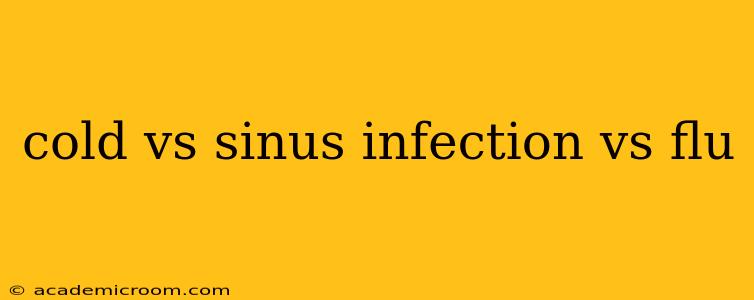Knowing whether you're battling a common cold, a sinus infection, or the flu can be tricky, as they share some similar symptoms. However, understanding the key differences can help you seek appropriate treatment and prevent complications. This guide will help you differentiate between these three common illnesses.
What are the Key Differences?
The common cold, sinus infection (sinusitis), and influenza (the flu) all affect the respiratory system, but they differ in their severity, symptoms, and underlying causes.
Common Cold: Typically caused by rhinoviruses, but other viruses can also be culprits. It usually presents with milder symptoms and a shorter duration than the flu or a sinus infection.
Sinus Infection: Often a complication of a cold or allergies, a sinus infection involves inflammation and infection of the sinuses. Bacteria or viruses can cause it. Symptoms are focused on the sinuses and can persist for longer.
Flu: Caused by influenza viruses (types A and B), the flu is generally more severe than a cold and can lead to serious complications, especially in vulnerable populations. Its symptoms are more intense and systemic.
How Can I Tell Them Apart? (Addressing Common Questions)
Here's a breakdown addressing common questions people have when trying to distinguish between these conditions:
What are the symptoms of a cold, sinus infection, and the flu?
This is the most critical aspect of differentiating between the three. Let's look at each illness individually:
Common Cold Symptoms:
- Mild symptoms: Runny or stuffy nose, sneezing, sore throat, mild cough, maybe some mild body aches.
- Gradual onset: Symptoms develop gradually over a day or two.
- Short duration: Usually lasts 7-10 days.
- Low fever (or no fever): Fever, if present, is typically low-grade.
Sinus Infection Symptoms:
- Facial pain and pressure: Pain and pressure around the eyes, cheeks, forehead, and/or nose are key indicators.
- Thick, discolored nasal discharge: The mucus might be yellow-green or even brownish.
- Congestion: Significant nasal congestion.
- Cough: May develop a cough, often more persistent than with a cold.
- Fatigue: Can be more pronounced than with a cold.
- Longer duration: Symptoms typically last for 10 days or more.
Flu Symptoms:
- Sudden onset: Symptoms develop rapidly within a few hours.
- High fever: Often a high fever (100°F or higher).
- Severe body aches: Intense muscle aches and pains.
- Chills and sweats: Often feel very cold and then break out in a sweat.
- Fatigue: Extreme fatigue and weakness.
- Headache: Severe headache.
- Dry cough: A dry, persistent cough is common.
- Sore throat: Can be severe.
- Shortness of breath: In severe cases, shortness of breath can occur.
How long do these illnesses typically last?
As mentioned above, the duration varies significantly:
- Cold: 7-10 days
- Sinus Infection: 10 days or more, sometimes weeks if untreated.
- Flu: Symptoms may last 5-7 days, but fatigue can persist for several weeks.
How are they treated?
Treatment focuses on managing symptoms, and it's crucial to distinguish between them for appropriate treatment:
- Cold: Rest, fluids, and over-the-counter medications for symptom relief (pain relievers, decongestants).
- Sinus Infection: May require antibiotics if a bacterial infection is suspected (a doctor's visit is essential). Also, saline nasal sprays and decongestants can help.
- Flu: Rest, fluids, over-the-counter medications for symptom relief. Antiviral medications may be prescribed by a doctor if treatment is started early.
When should I see a doctor?
Consult a doctor if:
- Your symptoms are severe or worsening.
- You have a high fever.
- You have difficulty breathing.
- Your symptoms last longer than usual.
- You have underlying health conditions.
This information is for general knowledge and does not replace professional medical advice. Always consult a healthcare professional for diagnosis and treatment.
